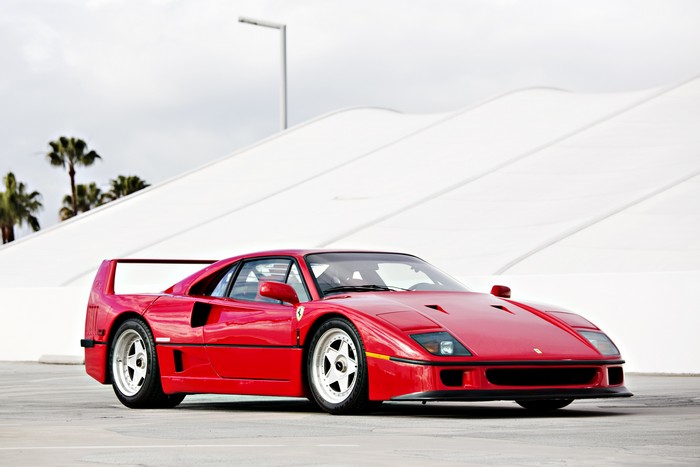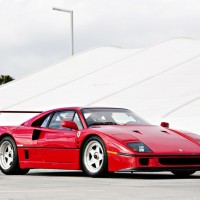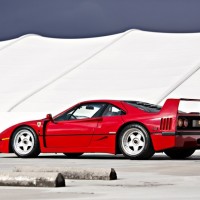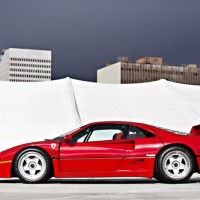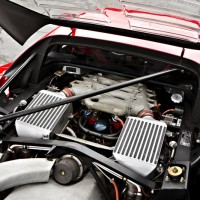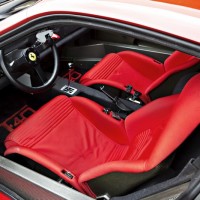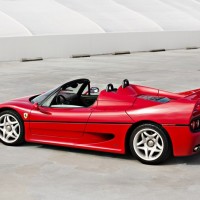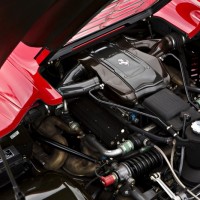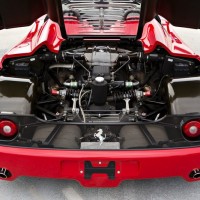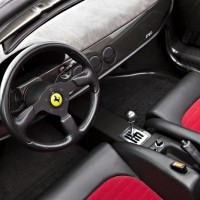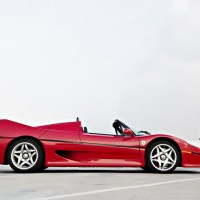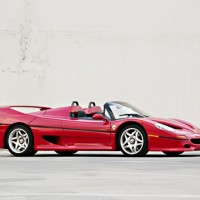1990 Ferrari F40
• The last Enzo-era Ferrari
• One of only 213 U.S.-specification F40s
• Displayed at Concorso Italiano in 1991 and 1993
• Approximately 7,050 miles from new
• Very original, unmodified example
• Recently serviced at Norbert Hofer’s Grand Touring Classics
• Offered with owner handbooks and tool kit
• Ferrari historian Marcel Massini documentation
• Recent $22,000 service at Grand Touring Classics Inc.
1995 Ferrari F50
• A groundbreaking Ferrari supercar
• The 10th of only 349 built
• A U.S.-specification F50 delivered new to California
• A two-owner car with less than 500 miles from new
• Featured in the May 2010 issue of Forza magazine
• In untouched, as-delivered condition
• Complete with hard top, books, tool kit and luggage
SCM Analysis
Detailing
| Vehicle: | 1990 Ferrari F40 |
| Number Produced: | 1,311 |
| Original List Price: | $400,000 |
| Tune Up Cost: | $4,000 |
| Chassis Number Location: | Stamped on the frame in front compartment under washer bottle |
| Engine Number Location: | On top of the engine by the water pump |
| Club Info: | Ferrari Club of America |
| Website: | http://www.FerrariClubofAmerica.org |
The 1995 Ferrari F50, Lot 21, sold for $1,375,000, including buyer’s premium, at Gooding & Company’s Amelia Island Auction on March 8, 2013. The 1990 Ferrari F40, Lot 32, sold for $715,000, including buyer’s premium, at Gooding and Company’s Amelia Island Auction on March 8, 2013.
Two valuable Ferrari supercars sell on the same day at the same auction — and before many expert Ferrari collectors. Why the huge price gaps between the two coveted cars?
But, first, a little history.
The F40
The F40 was introduced to celebrate Ferrari’s 40th anniversary. The F50 celebrated Ferrari’s 50th anniversary. Both are limited-edition supercars — and both cars are spectacular.
While both are showcases of high-performance technology, they are distinctly different. The F40 is a GT car engineered to race-car abilities. The F50 is a race car engineered to be driven on the street. Each car is admirable in the way they do their job and each is worthy of the supercar moniker.
The F40 came on the heels of the 288 GTO and owes the 288 for its existence. A race version of the 288 called the Evoluzione was prepared for racing in the World Rally Championship, but rule changes made it ineligible. About this same time, Enzo Ferrari challenged his engineers to “build a car to be best in the world.” Using the Evoluzione as a base, the engineers built an answer to Enzo’s charge.
The new car was ready about the time of Ferrari’s 40th anniversary, and in a stroke of marketing genius it was named the F40 to commemorate the occasion. The car made the cover of virtually every major automobile magazine, with articles celebrating the car and the company’s 40-year history. It was a marketing coup that deserves its own story.
The F40 uses a traditional Ferrari oval tube frame with unequal A-arms and tubular coil-over shocks. It features a turbocharged 478-hp, 3-liter V8 engine. The F40 interior is bare bones, with a carbon-fiber floor pan void of carpeting. The dash and interior hard surfaces are covered with a felt material. The carbon-fiber racing seats are covered in red, fire-retardant cloth. The interior door releases are racing-style wire pulls. Air conditioning was standard, but creature comforts, such as electric windows or a radio, were not available.
Driving an F40 is a real treat. A press of the starter button springs the engine to life. Turbochargers are a natural muffler, so the engine has a nice snarl without being particularly loud. There is no sound-deadening material, and the floorboards seem to amplify the road noise. The sound is a sensation that is part of the excitement of traveling in an F40.
It takes a good amount of throttle to get into turbo boost, so it’s possible to drive an F40 quickly before releasing the beast. When you do get into boost, you’d better be ready. The F40’s power explodes. You are immediately at redline, and the car is as fast as you can shift. Unless you’re on a track, the high gears are useless, but hitting the gas in second and third is intoxicating. The sound is incredible, and the sensation is unequalled in any street car.
The F40 is a remarkably dependable car. The mechanicals are nearly bulletproof if the car is properly serviced. The seat fabric is a weak link, as it fades and wears over time. The headliners are also starting to give way. The clear coat on the F40 wheels has a tendency to develop hairline cracks. Mechanical spares are readily available, but trim parts are scarce.
The F50
The F50’s lineage comes directly from Ferrari’s racing efforts. The concept was to offer a Formula One car experience in a road car. Ferrari started with a carbon-fiber tub — and then attached a de-tuned, 12-cylinder Formula One engine directly to the tub. The suspension is racing-style, with heim-jointed wishbones, pushrods and electronically controlled coil-over shocks mounted horizontally. The gearbox is a manual 6-speed, and the brakes are manual with no power booster or ABS.
The sum of all these parts is a very serious missile that really takes the Formula One experience to the driver.
Interior trim on the F50 is a step up from the F40. The seats are racing shells, but they have leather bolsters. The hard surfaces are upholstered in leather. The windows are still hand-cranked, but the interior door releases are traditional handles. The dash followed Formula One practice with a digital display.
Hitting the starter button takes you to a place you’ve never been before. The mechanical noise and vibration from the engine compartment is disarming until you process what’s going on. Behind you, the front end of the engine is bolted directly to the bulkhead. There are no rubber motor mounts. All the engine vibration and mechanical noise is telegraphed directly to the tub. It is an exhilarating experience that is unique in the road-car world.
The F50 has a racing-style fuel cell with a rubber bladder. Ferrari recommends replacing the bladder every 10 years. Fortunately, the F50 does not need a cam belt service, so there is some transfer of expense. The digital dash is also prone to failure, but there are at least two shops that can rebuild them.
Decisions, decisions
The F40 was a highly desirable car. The car has 7,050 miles on the clock, which is a sweet spot, in that the car can be driven a few thousand miles and still be under 10,000 miles. It also had been recently serviced.
There are very few F40s on the market, and that means prices are often higher than expected. The sales price of $715,000 may have been a mid-estimate result, but it was over market for a 7,000-mile car. The seller came out on top with this one, but when the buyer drives his new car, any overpayment will be quickly forgotten.
The F50’s body is less aggressive than the F40’s, and the interior is more plush. It is easy to dismiss the F50 as a lesser car, but that’s a mistake. The F50 is a serious supercar that truly delivers a race-car experience.
Very few F50s hit the market in any one year, and like the F40, availability trumps price. You can make more money, but you can’t buy time. Buyers need to pull the trigger when they find a good car. It can be months before another is available, and there’s a good chance the next one will be more expensive.
Low miles, good history
The F50 was particularly desirable because of the ultra-low mileage — less than 500 miles — and known history. It suffered from a lack of expensive maintenance, but that’s hardly a factor at this price.
At least three other F50s have sold for more than a million dollars this year. The money seems unusually high — until you consider that a McLaren F1 might sell for three times more. This one was well sold and well bought. ?
(Introductory description courtesy of Gooding & Company.)
